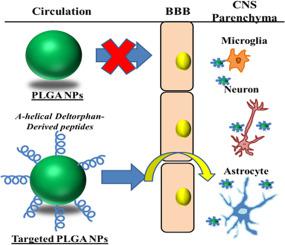Nanomedicine: Nanotechnology, Biology and Medicine ( IF 4.2 ) Pub Date : 2020-05-29 , DOI: 10.1016/j.nano.2020.102226 Jason T Duskey 1 , Ilaria Ottonelli 2 , Federica Da Ros 3 , Antonietta Vilella 4 , Michele Zoli 4 , Sandra Kovachka 5 , Francesca Spyrakis 5 , Maria A Vandelli 6 , Giovanni Tosi 6 , Barbara Ruozi 6

|
Central nervous system (CNS) compartments remain one of the most difficult districts for drug delivery. This is due to the presence of the blood–brain barrier (BBB) that hampers 90% of drug passage, dramatically requiring non-invasive treatment strategies. Here, for the first time, the use of opioid-derived deltorphin-derivative peptides to drive biodegradable and biocompatible polymeric (i.e. poly-lactide-co-glycolide, PLGA) nanomedicines delivery across the BBB was described. Opioid-derived peptides were covalently conjugated to furnish activated polymers which were further used for fluorescently tagged nanoformulations. Beyond reporting production, formulation methodology and full physico-chemical characterization, in vivo tests generated clear proof of BBB crossing and CNS targeting by engineered nanomedicines opening the research to further applications of drug delivery and targeting in CNS disease models.
中文翻译:

用于脑靶向的新型肽缀合纳米药物:体内证据。
中枢神经系统(CNS)隔室仍然是最困难的药物输送区之一。这是由于血脑屏障(BBB)的存在阻碍了90%的药物通过,因此急需无创治疗策略。在此,首次描述了使用阿片类药物衍生的三氢卟酚衍生物肽来驱动可生物降解的和生物相容性的聚合物(即,丙交酯-乙交酯共聚物,PLGA)纳米药物跨BBB的传递。阿片样物质衍生的肽共价缀合以提供活化的聚合物,该聚合物进一步用于荧光标记的纳米制剂。除了报告生产,配方方法和完整的理化特性外,











































 京公网安备 11010802027423号
京公网安备 11010802027423号